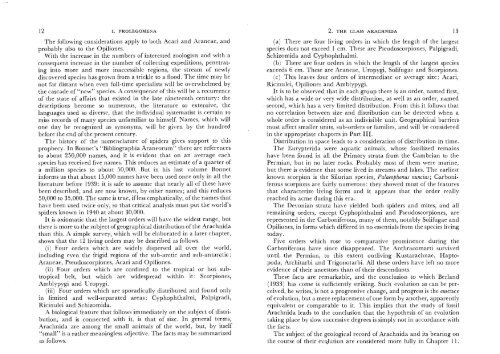You also want an ePaper? Increase the reach of your titles
YUMPU automatically turns print PDFs into web optimized ePapers that Google loves.
12 I. PROLEGOMENA<br />
The following considerations apply to both Acari and Araneae, and<br />
probably also to the Opiliones.<br />
\Vith the increase in the numbers of interested zoologists and with a<br />
consequent increase in the number of collecting expeditions, penetrating<br />
into more and more inaccessible regions, the stream of newly<br />
discovered species has grown from a trickle to a flood. The time may be<br />
not far distant when even full-time specialists will be overwhelmed by<br />
the cascade of "new" species. A consequence of this will be a recurrence<br />
of the state of affairs that existed in the late nineteenth century: the<br />
descriptions become so numerous, the literature so extensive, the<br />
languages used so diverse, that the individual systematist is certain to<br />
miss records of many species unfamiliar to himself. Names, which will<br />
one day be recognized as synonyms, will be given by the hundred<br />
before the end of the present century.<br />
The history of the nomenclature of spiders gi;-es support to this<br />
prophecy. In Bonnet's "Bibliographia Araneorum" there are references<br />
to about 250,000 names, and it is evident that on an average each<br />
species has received five names. This reduces an estimate of a quarter of<br />
a million species to about 50,000. But in his last volume Bonnet<br />
informs us that about 15,000 names have been used once only in all the<br />
literature before 1939: it is safe to assume that nearly all of these have<br />
been described, and are now known, by other names; and this reduces<br />
50,000 to 35,000. The same is true, ifless emphatically, of the names that<br />
have been used twice only, so that critical analysis must put the world's<br />
spiders known in 1940 at about 30,000.<br />
It is axiomatic that the largest orders will have the widest range, but<br />
there is more to the subject of geographical distribution of the <strong>Arachnida</strong><br />
than this. A simple survey, which will be elaborated in a later chapter,<br />
shows that the 12 living orders may be described as follows.<br />
(i) Four orders which are widely dispersed all over the world,<br />
including even the frigid regions of the sub-arctic and sub-antarctic:<br />
Araneae, Pseudoscorpiones, Acari and Opiliones.<br />
(ii) Four orders which are confined to the tropical or hot subtropical<br />
belt, but which are widespread within it: Scorpiones,<br />
Amblypygi and Cropygi.<br />
Four orders which are sporadically distributed and found only<br />
in limited and well-separated areas: Cyphophthalmi, Palpigradi,<br />
Ricinulei and Schizomida.<br />
A biological feature that follows immediately on the subject of distribution,<br />
and is connected with it, is that of size. In general terms,<br />
<strong>Arachnida</strong> are among the small animals of the world, but, by itself<br />
"small" is a rather meaningless adjective. The facts may be summarized<br />
as follows.<br />
2. THE CI~ASS ARACHNIDA 13<br />
(a) There are four living orders in which the length of the largest<br />
species does not exceed 1 cm. These are Pseudoscorpiones, Palpigradi,<br />
Schizomida and Cyphophthalmi.<br />
There are four orders in which the length of the largest species<br />
exceeds 6 cm. These are Araneae, Uropygi, Solifugae and Scorpiones.<br />
(c) This leaves four orders of intermediate or average size: Acari,<br />
Ricinulei, Opiliones and Amblypygi.<br />
It is to be observed that in each group there is an order, named first,<br />
which has a wide or very wide distribution, as well as an order, named<br />
· second, which has a very limited distribution. From this it follows that<br />
no correlation between size and distribution can be detected when a<br />
whole order is considered as an indivisible unit. Geographical barriers<br />
must affect smaller units, sub-orders or families, and will be considered<br />
in the appropriate chapters in Part Ill.<br />
Distribution in space leads to a consideration of distribution in time.<br />
The Eurypterida were aquatic animals, whose fossilized remains<br />
have been found in all the Primary strata from the Cambrian to the<br />
Permian, but in no later rocks. Probably most of them were marine,<br />
but there is evidence that some lived in streams and lakes. The earliest<br />
known scorpion is the Silurian species, Palaeophonus nuncius; Carboniferous<br />
scorpions are fairly numerous: they showed most of the features<br />
that characterize living forms and it appears that the order really<br />
reached its acme during this era.<br />
The De,·onian strata have yielded both spiders and mites, and all<br />
remaining orders, except Cyphophthalmi and Pseudoscorpiones, are<br />
represented in the Carboniferous, many of them, notably Solifugae and<br />
Opiliones, in forms which differed in no essentials from the species living<br />
today.<br />
Five orders which rose to comparative prominence during the<br />
Carboniferous have since disappeared. The Anthracomarti survived<br />
until the Permian, to this extent outliving Kustarachnae, Haptopoda,<br />
Architarbi and Trigonotarbi. All these orders have left no more<br />
evidence of their ancestors than of their descendants.<br />
These facts are remarkable, and the conclusion to which Berland<br />
( 1933) has come is sufficiently striking. Such evolution as can be perceived,<br />
he writes, is not a progressive change, and progress is the essence<br />
of evolution, but a mere replacement of one form by another, apparently<br />
equivalent or comparable to it. This implies that the study of fossil<br />
<strong>Arachnida</strong> leads to the conclusion that the hypothesis of an evolution<br />
taking place by slow successive degrees is simply not in accordance with<br />
the facts.<br />
The subject of the geological record of <strong>Arachnida</strong> and its bearing on<br />
the course of their evo.lution are considered more fully in Chapter 11.















